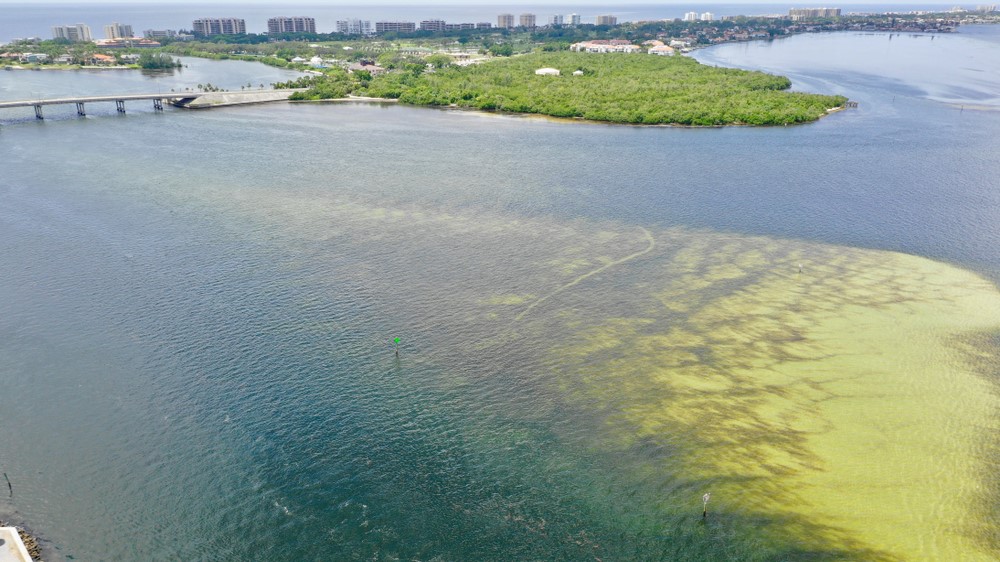Sharks hide in Florida canal to escape toxic red tide sweeping the coast
It is unknown how long the sharks will seek refuge in the waterways.

Hundreds of sharks are currently hiding out in a canal in Florida as they attempt to escape a toxic algal bloom sweeping the state's Gulf Coast, according to news reports.
Four shark species — bonnethead (Sphyrna tiburo), blacktip (Carcharhinus limbatus), nurse (Ginglymostoma cirratum) and lemon (Negaprion brevirostris) — have been hiding in the canal near Longboat Key in Sarasota County since July 26, according to The Guardian. Local residents shared striking footage of the shark-infested waterway online.
Experts think the sharks have retreated into the canals to avoid the red tide — an out-of-control growth of teensy plants called algae that releases a powerful neurotoxin — along the Florida coast, which has entered the food chain and caused widespread damage to the marine ecosystem.
Related: 13 bizarre things that washed up on beaches
"You just don't normally see sharks piling up like that in these canals; they do go in there but not in the huge numbers that we're seeing reported," Mike Heithaus, a marine ecologist and shark expert at Florida International University, told The Guardian. "It's not the kind of thing that you would see if it wasn't a big red tide event."
Red tide
The ride tide is a common name for blooms created by the phytoplankton Karenia brevis, a species that releases a neurotoxin called brevetoxin that can disrupt the firing of nerve cells, according to the Smithsonian National Museum of Natural History.

Algal blooms can occur when excess nutrients, such as nitrogen and phosphorus, enter the ocean through river systems. This causes the algae to grow and reproduce rapidly and uncontrollably. Excess nutrients can result from flooding and soil erosion, but they also come from fertilizer and animal excrement runoff from agricultural farms.
Get the world’s most fascinating discoveries delivered straight to your inbox.
In addition to being lethal to marine mammals, birds, turtles and fish, red tide can cause health problems for humans. People often get sick by eating neurotoxin-contaminated shellfish or swimming in areas with a high concentration of the toxic algae, and the brevetoxin can also become airborne and cause breathing problems for people with asthma and other respiratory conditions, according to the National Oceanographic and Atmospheric Administration (NOAA).
In total, algal blooms cost the U.S. about $82 million in economic losses every year, due to the impacts on fishing and tourism, according to NOAA.
Major bloom
This year's red tide, which began back in December 2020, is one of the worst ever in Florida. In July, more than 800 tons (725 metric tons) of dead fish and sea life, including dolphins and manatees, washed ashore in Pinellas County along the Gulf Coast, according to The Guardian.
The recent high winds from Tropical Storm Elsa, which hit Florida on July 7, may have increased the number of fish and other dead animals that washed ashore, which some scientists say could be making the red tide appear worse than normal by making the devastation more visible to people, according to The Guardian.
But experts believe that a recent malfunction at the Piney Point power plant in Manatee County may be partly to blame for this year's long-lasting red tide. In late March, a dam at the plant's reservoir, which stores water full of phosphorus and nitrogen, began to fail. On March 30, Florida officials released more than 35 million gallons (132 million liters)of contaminated water into Tampa Bay, which is connected to the Gulf of Mexico, to ease pressure on the dam so it could be repaired, Live Science previously reported.
This released water may have provided the algae with the nutrients they needed to grow out of control.
"I don't think it would've taken off to the levels that we're seeing without Piney Point," Robert Weisberg, an oceanographer at the University of South Florida, told local news station WTSP.
Retreating to canals
In the past eight days, very high concentrations of K. brevis have been focused around St. Petersburg and Sarasota, according to the Florida Fish and Wildlife Conservation Commission. This has caused the sharks in the area to retreat into the canal in Longboat Key.
"We don't know what the trigger might be for those sharks going to those areas, but the changes in the chemistry of the water, the oxygen being pulled out of the water, the toxins, combined with the amount of dead fish around — any of those could cause these big concentrations," Heithaus told The Guardian.
As the red tide persists, it is unclear how long the sharks may be stuck.
"If the conditions are really bad outside that canal, they might be stuck until the conditions get to the point where there's enough oxygen or there aren't toxins if they were to leave the canals," Heithaus said.
This is potentially concerning because the high concentration of sharks in such a small area could lead to a depletion of their food.
"If it goes on long enough, they will run out of food and energy, and unfortunately, some of them — if not all of them — will die," Jack Morris, a senior biologist at Mote Marine Laboratory in Florida, told local station Fox 13.
If excess nutrients keep making their way into the oceans, the red tide will continue to be a problem for sharks and other marine life in the future.
"Seeing these kinds of things happen just shows how out of balance things are in the ecosystem right now," Heithaus said. "We really need to start working very hard in Florida on addressing some of the causes of these blooms."
Originally published on Live Science.

Harry is a U.K.-based senior staff writer at Live Science. He studied marine biology at the University of Exeter before training to become a journalist. He covers a wide range of topics including space exploration, planetary science, space weather, climate change, animal behavior and paleontology. His recent work on the solar maximum won "best space submission" at the 2024 Aerospace Media Awards and was shortlisted in the "top scoop" category at the NCTJ Awards for Excellence in 2023. He also writes Live Science's weekly Earth from space series.
